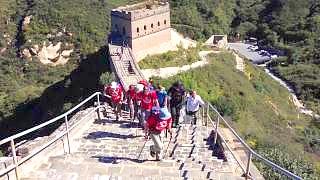
|
Don't miss it ...
00:06
北京故宫千秋亭
(Beijing Forbidden City, QianQiu Pavilion)
00:12
紫禁城
(Forbidden city)
00:19
甘肃嘉峪关
(Gansu Jiayuguan)
00:29
中国台湾竹林山观音寺
(Guanyin Temple, Zhulin Mountain, Taiwan, China)
00:37
江苏无锡灵山大佛
(Jiangsu Wuxi Lingshan Buddha)
00:46
四川稻城白塔
(Sichuan Daocheng Baita)
00:50
山西太原蒙山大佛
(Mengshan Buddha, Taiyuan, Shanxi)
01:11
四川巴塘措普湖
(Sichuan Batang Thomp Lake)
01:20
云南泸沽湖里格半岛
(Yunnan Lihu Peninsula)
01:29
西藏羊卓雍措
(Tibet Yangzhuo)
01:37
河南王屋山
(Henan Wangwushan)
01:42
江西庐山
(Jiangxi Lushan)
01:47
江西婺源
(Jiangxi Wuyuan)
01:51
湖南张家界
(Zhangjiajie, Hunan)
01:59
四川那玛峰
(Naama Peak, Sichuan)
02:13
乌鲁木齐天格尔峰
(Urumqi Tiangle Peak)
02:22
四川雅哈垭口
(Sichuan Yaha Pass)
02:34
杭州西湖曲院风荷
(Hangzhou West Lake Quyuan Fenghe)
02:43
江西新余
(Jiangxi Xinyu)
02:47
广西桂林
(Guilin)
02:58
湖北武汉东湖
(Wuhan East Lake, Hubei)
03:03
海南三亚海上观音
(Hainan Sanya Sea Goddess of Mercy)
03:07
贵州千户苗寨
(Guizhou Qianhu Miao Village)
03:12
浙江宁波
(Ningbo, Zhejiang)
03:16
南京美龄宫
(Nanjing Meiling Palace)
03:20
上海
(Shanghai)
03:24
江苏苏州
(Suzhou, Jiangsu)
03:28
广东广州
(Guangzhou, Guangdong)
03:33
中国香港
(Hong Kong, China)
03:38
中国澳门
(Macao, China)
03:40
北京三里屯
(Beijing Sanlitun)
03:41
宁夏银川鼓楼
(Ningxia Yinchuan Drum Tower)
03:44
黑龙江哈尔滨大教堂
(Harbin Cathedral, Heilongjiang Province)
03:46
云南昆明官渡古镇
(Guandu Ancient Town, Kunming, Yunnan)
03:48
广东广州中山纪念堂
(Zhongshan Memorial Hall, Guangzhou, Guangdong)
03:51
天津小白楼
(Tianjin Xiaobai Building)
03:53
湖北襄阳唐城
(Tangyang City, Hubei Province)
03:55
安徽歙县
(Yixian County, Anhui Province)
03:59
吉林长白山天池
(Jilin Changbai Mountain Tianchi)
04:04
湖南张家界武陵源
(Wulingyuan, Zhangjiajie, Hunan)
04:12
重庆潼南
(Chongqing Weinan)
04:15
北京大兴机场
(Beijing Daxing Airport)
04:17
青海昆仑眼
(Qinghai Kunlun Eye)
04:19
南海三沙蓝洞
(Nansha Sansha Blue Cave)
04:21
上海陆家嘴环路
(Shanghai Lujiazui Ring Road)
04:23
陕西西安钟楼
(Xi'an Bell Tower, Shaanxi)
04:25
重庆洪崖洞
(Chongqing Hongyadong)
04:27
山西临汾华门
(Linyi Huamen, Shanxi)
04:30
陕西雨岔大陕谷
(Shaanxi Rainy Dashan Valley)
04:32
新疆开都河
(Kaidu River, Xinjiang)
04:34
新疆伊犁新源
(Xinjiang Yili Xinyuan)
04:36
云南文山普者黑
(Yunnan Wenshan Puzhehei)
04:39
新疆昌吉江布拉克
(Xinjiang Changji River Braque)
04:41
浙江台州大陈岛荧光海
(Fluorescent Sea, Dachen Island, Taizhou, Zhejiang)
04:43
新疆禾木
(Xinjiang Hemu)
04:46
安徽黄山
(Anhui Huangshan)
04:48
安徽休宁县
(Xiuning County, Anhui Province)
04:49
江西武功山
(Jiangxi Wugong Mountain)
04:50
福建厦门
(Fujian Xiamen)
04:51
福建土楼
(Fujian Tulou)
04:52
甘肃七彩丹霞
(Gansu colorful Danxia)
04:53
甘肃敦煌月牙泉
(Gansu Dunhuang Crescent Spring)
04:54
贵州黄果树瀑布
(Guizhou Huangguoshu Waterfall)
04:55
贵州贵阳
(Guiyang, Guizhou)
04:56
贵州FAST天眼望远镜
(Guizhou FAST sky telescope)
04:58
广东汕尾凤山妈祖像
(Guangdong Shanwei Fengshan Mazu statue)
04:59
广东惠州汉月湾
(Huizhou Hanyue Bay, Guangdong)
05:00
广东南沙大桥
(Guangdong Nansha Bridge)
05:01
广东广州中轴线
(Guangdong Guangzhou Central axis)
05:02
广东深圳华润总部
(Guangdong Shenzhen China Resources Headquarters)
05:03
广东深圳机场
(Guangdong Shenzhen Airport)
05:04
湖北武汉长江
(Wuhan Yangtze River, Hubei)
05:05
湖北武汉黄鹤楼
(Yellow Crane Tower, Wuhan, Hubei)
05:06
湖北武汉东湖樱园
(Wuhan East Lake Sakura Garden, Hubei)
05:07
湖北长阳天柱山
(Tianzhu Mountain, Changyang, Hubei)
05:08
湖北荆州古城
(Ancient city of Jingzhou, Hubei)
05:10
宁夏中华黄河楼
(Ningxia Zhonghua Yellow River Building)
05:11
河南老君山
(Laojun Mountain, Henan)
05:12
河南龙门石窟
(Longmen Grottoes, Henan)
05:13
黑龙江哈尔滨冰雪大世界
(Harbin Ice and Snow World in Heilongjiang Province)
05:14
黑龙江大庆芍药花海
(Heilongjiang Daqing peony flower sea)
05:15
湖南长沙大剧院
(Hunan Changsha Grand Theatre)
05:16
湖南凤凰古镇
(Fenghuang Ancient Town, Hunan)
05:17
吉林集安
(Jilin Ji'an)
05:18
辽宁沈阳
(Shenyang, Liaoning)
05:20
辽宁大连星海湾大桥
(Dalian Xinghai Bay Bridge, Liaoning)
05:21
辽宁大连长兴岛
(Changxing Island, Dalian, Liaoning)
05:22
江苏扬州瘦西湖
(Slender West Lake, Yangzhou, Jiangsu)
05:23
江苏苏州十里斜塘
(Suzhou Shili Liantang)
05:24
江苏南京灵谷寺萤火虫
(Fireflies in Linggu Temple, Nanjing, Jiangsu)
05:25
江苏南京平流雾
(Nanjing Nanjing River)
05:26
广西柳州
(Liuzhou, Guangxi)
05:27
广西桂林相公山
(Xianggong Mountain, Guilin, Guangxi)
05:28
广西德天瀑布
(Guangxi Detian Waterfall)
05:29
广西百色福禄河
(Guangxi Baise Fulu River)
05:30
青海格尔木河
(Qinghai Golmud River)
05:32
青海俄博梁
(Qinghai Russian Boliang)
05:33
青海哈拉湖
(Qinghai Lake Hala)
05:34
青海湖
(Qinghai Lake)
|

 A day in XiTang 喜糖, ZheJiang Province
A day in XiTang 喜糖, ZheJiang Province





